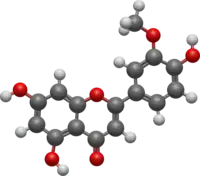Chrysoeriol
Chrysoeriol is a flavone, chemically the 3'-methoxy derivative of luteolin.
 | |
 | |
| Names | |
|---|---|
| IUPAC name
4′,5,7-Trihydroxy-3′-methoxyflavone | |
| Systematic IUPAC name
5,7-Dihydroxy-2-(4-hydroxy-3-methoxyphenyl)-4H-1-benzopyran-4-one | |
| Identifiers | |
3D model (JSmol) |
|
| ChemSpider | |
| ECHA InfoCard | 100.007.039 |
PubChem CID |
|
| UNII | |
CompTox Dashboard (EPA) |
|
| |
| |
| Properties | |
| C16H12O6 | |
| Molar mass | 300.266 g·mol−1 |
Except where otherwise noted, data are given for materials in their standard state (at 25 °C [77 °F], 100 kPa).
Infobox references | |
Related compounds
Diosmetin is one of three possible regioisomers of chrysoeriol.
Natural sources
Found in Artemisia.
Pharmacodynamics
Vasorelaxant and hypotensive activity in vitro and in vivo in a murine model by intravenous infusion.[1]
See also
- Cannflavins, prenylated derivatives of chrysoeriol
References
- Gorzalczany, S; Moscatelli, V; Ferraro, G (2013). "Artemisia copa aqueous extract as vasorelaxant and hypotensive agent". J Ethnopharmacol. 148 (1): 56–61. doi:10.1016/j.jep.2013.03.061. PMID 23588093.
This article is issued from Wikipedia. The text is licensed under Creative Commons - Attribution - Sharealike. Additional terms may apply for the media files.